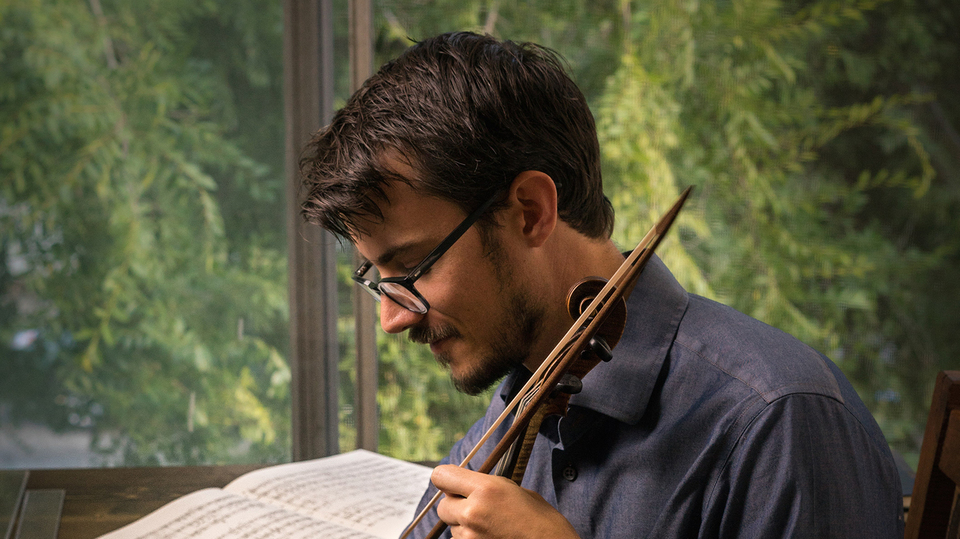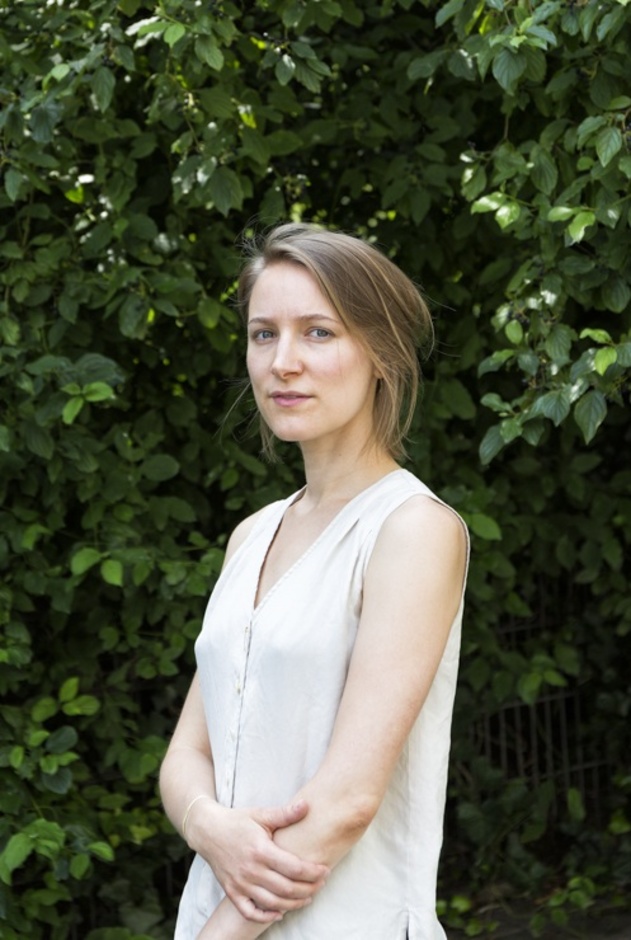
Andrew Nathaniel McIntosh: Forgotten Tunings
Bridging the worlds of Baroque and experimental practices, Andrew Nathaniel McIntosh performs selections from Heinrich Biber’s “Rosary Sonatas,” a series of works each with different violin tunings that was all but lost from their composition in c. 1676 until the 20th century. Interspersed with these sonatas are pieces by experimental tuning theorist and practitioner Wolfgang Von Schweinitz, the delicate scordatura harmonics of Catherine Lamb’s solo violin work open-scape, and the full expanse of violin techniques from Anahita Abbasi. McIntosh will be accompanied on the Biber sonatas by Ian Pritchard, an early music keyboardist and musicologist.
LA-based violinist/composer Andrew McIntosh has a unique and multifaceted career spanning solo, chamber, and early music engagements across the US and in Europe. He performs frequently with period instrument ensembles Bach Collegium San Diego, Musica Angelica, and Tesserae. He is a founding member of the Formalist Quartet, which focuses on new repertoire and is currently in its 12th season, and has appeared as a soloist at the San Francisco Symphony’s SoundBox series, REDCAT in Walt Disney Concert Hall, Miller Theatre in New York, and festivals in Switzerland, Austria, Germany, and the Netherlands.
His compositions have been featured at major venues in The Netherlands, Germany, Austria, Switzerland, England, Scotland, Los Angeles, and New York, including several recent performances at the Los Angeles Philharmonic’s Green Umbrella series in Walt Disney Concert Hall and at Miller Theatre in New York. He has received commissions from organizations such as the LA Philharmonic, The Industry Opera Company, Calder Quartet, and Los Angeles Percussion Quartet. He is based in the LA area and currently serves on the faculty of the California Institute of the Arts teaching violin, viola, composition, chamber music, and baroque performance practice.
Ian Pritchard, early keyboardist and musicologist, is active as a performer and as a researcher. As a continuo player he has performed with many leading early music ensembles, such as the Academy of Ancient Music, the Orchestra of the Age of Enlightenment, and Florilegium (with which he has toured in Europe and in South America). He earned degrees in harpsichord from Oberlin Conservatory and from the Royal Academy of Music, London, and is currently a PhD candidate in musicology at USC (Los Angeles). In 2003 - 2004 Ian was awarded a Fulbright Scholarship to Italy. In 2015 he was elected an Associate of the Royal Academy of Music. He is currently on faculty at the Colburn School Conservatory of Music.
Anahita Abbasi:
Situation IV / Io E iO
Dialogical Self Theory weaves two concepts, self and dialogue, together in such a way that a more profound understanding of the interconnection of self and society is achieved. Usually, the concept of self refers to something “internal,” something that takes place within the mind of the individual person, while dialogue is typically associated with something “external,” that is, processes that take place between people involved in communication.
The composite concept “dialogical self” goes beyond the self-other dichotomy by infusing the external to the internal and, in reverse, to introduce the internal into the external. As functioning as a “society of mind”,the self is populated by multiplicity of “self-positions” that have the possibility to entertain dialogical relationships with each other.
Situations are series of pieces with a set of circumstances in which one finds oneself.
Situation IV/Io e iO, is a “Dialogical Self” of a musician with himself, a multiplicity of “ self -positions”, and infusion of the external and internal dialogues in different kinds of situations. (—AA)
“Anahita’s music is powerful and vigorous and consists of multiple layers. As it is also vivid from the titles of her works such as Dialogues, Situations, Distorted Attitudes, and etc; she investigates and gesticulate thoughts and feelings; At the same time it is manifestation/ observation of a scene or multiple scenes, which occur simultaneously; the content of which, however, never becomes more concrete, but remains delicate at the border. She has the tendency to take us with her music on a mystical, puzzling journey and leave us within our thoughts, to find out the “ ending” ourselves.”… ( Ernst. M. Binder)
Anahita Abbasi’s works have been performed around the world in various festivals such as: Darmstadt Ferienkurse, Ircam (Manifeste akademie), Matrix ( Experimental studio des SWR), Impuls festival, Time of music, Atlas festival and etc. In 2014, she received the work-scholarship from Experimentalstudio des SWR in Freiburg. The Recipient of 2015 Morton Gold ASCAP young composers award, is also nominated in 2017 as the “women composers of our time” along side with Kaja Saariaho and Isabel Mundry. She is one of the founders of Schallfeld Ensemble in Graz, Austria.
Anahita Abbasi graduated from the University of music and performing Arts Graz, Austria; where she studied music theory with Clemens Gadenstätter & composition with Beat Furrer and Pierluigi Billone; while working closely with Georges Aperghis, Franck Bedrossian and Philippe Leroux. Anahita is currently residing in San Diego and pursuing her Phd in Composition with Rand Steiger at the University of California San Diego.
[soundcloud.com/anahita-abbasi](http://www.soundcloud.com/anahita-abbasi)
Heinrich Biber:
Sonata VI from 8 Sonatas
Catherine Lamb:
open-scape

Catherine Lamb’s work open-scape is an early example of a kind of “unfurling” process in her work — a small interval, usually a “detuned unison,” begins as a beating dissonance and gradually expands to be defined through some specific rational relationship. In open-scape, Lamb starts with the interval 36:35, roughly a melodic quarter-tone consisting of two commas (syntonic and septimal) stacked atop one another. The specificity of the intervals are possible through a scordatura tuning in which the open strings are in unconventional harmonic series relationships with one another. But the experience of listening to Lamb’s work always includes not just the analytical mind, but also the actual, physical space; the beating relationships and interferences create unpredictable patterns in the acoustics of the specific room. The work is a gradual unfurling, and an exploration. (—ACS)
Catherine Lamb (b. 1982, Olympia, Wa, U.S.), is a composer exploring the interaction of elemental tonal material and the variations in presence between shades and beings in a room. She has been studying and composing music since a young age. In 2003 she turned away from the conservatory in an attempt to understand the structures and intonations within Hindustani Classical Music, later finding Mani Kaul in 2006 who was directly connected to Zia Mohiuddin Dagar and whose philosophical approach to sound became important to her. She studied (experimental) composition at the California Institute of the Arts (2004-2006) under James Tenney and Michael Pisaro, who were both integral influences. It was there also that she began her work into the area of Just Intonation, which became a clear way to investigate the interaction of tones and ever-fluctuating shades, where these interactions in and of them-selves became structural elements in her work. Since then she has written various ensemble pieces (at times with liminal electronic portions) and continues to go further into elemental territories, through various kinds of research, collaboration, and practice (herself as a violist). She received her MFA from the Milton Avery School of Fine Arts at Bard College in 2012 and is currently residing in Berlin, Germany.
Heinrich Biber:
Sonata X “The Crucifixion,” from Rosary Sonatas
Heinrich Biber:
Sonata VI “The Agony In the Garden,” from Rosary Sonatas
Wolfgang Von Schweinitz:
Plainsound Etude III
Etude 3 “György Ligeti & Gérard Grisey”
All of these three microtonal double-stop intonation studies are based on a flexible non-tempered sixth-tone scale. The sixth-tones, which were already promoted by Ferruccio Busoni more than 100 years ago, seem to be the smallest intervals that can easily be perceived as melodic steps, whereas yet smaller intervals tend to create the impression of an enharmonic retuning of the previous pitch.
I have employed various micro-chromatic scales during the past fifteen years in order to establish interesting and comprehensible microtonal harmonic modulations; but in this composition I have limited the number of scale degrees to 31 per octave to keep the steps between them melodic. Unlike in the tone system of 31-tone Equal Temperament, however, any scale degree may be represented by one of several different, yet similar pitches, each of which has a particular harmonic function within the musical context. – This flexible sixth-tone scale (from G-3 to G-4), which serves as a “cantus firmus” or theme for all three of the etudes, is a conceptual variation of James Tenney’s magnificent Koan for string quartet; and I also regard it as an homage to Marc Sabat’s ground-breaking List of Intervals Tunable by Ear.
Etude 2 also features the small chromatic semitone (with a frequency ratio of 25 : 24, i.e. circa 71 cents), which comes about in harmonic common-tone modulations into one of the upper or lower mediants, as already explored in the music of Nicola Vicentino and Don Carlo Gesualdo di Venosa. The 3rd etude emphasizes the familiar diatonic steps in order to preserve the old distinction between diatonic and chromatic melodic elements and redefine it within the new microtonal context. How to establish an elegant symbiosis between them, this is an issue György Ligeti was very concerned with; and that is why I dedicated this piece to my former teacher. But as my music also includes the melodic ¾-tone steps known from Persian music, it is paying tribute to Gérard Grisey as well, who embraced this powerful interval so unforgettably in his Quatre Chants pour franchir le seuil. (—WvS)
Heinrich Biber:
Sonata XIV “The Assumption of the Blessed Virgin,” from Rosary Sonatas
LA-based violinist/composer Andrew McIntosh has a unique and multifaceted career spanning solo, chamber, and early music engagements across the US and in Europe. He performs frequently with period instrument ensembles Bach Collegium San Diego, Musica Angelica, and Tesserae. He is a founding member of the Formalist Quartet, which focuses on new repertoire and is currently in its 12th season, and has appeared as a soloist at the San Francisco Symphony’s SoundBox series, REDCAT in Walt Disney Concert Hall, Miller Theatre in New York, and festivals in Switzerland, Austria, Germany, and the Netherlands.
His compositions have been featured at major venues in The Netherlands, Germany, Austria, Switzerland, England, Scotland, Los Angeles, and New York, including several recent performances at the Los Angeles Philharmonic’s Green Umbrella series in Walt Disney Concert Hall and at Miller Theatre in New York. He has received commissions from organizations such as the LA Philharmonic, The Industry Opera Company, Calder Quartet, and Los Angeles Percussion Quartet. He is based in the LA area and currently serves on the faculty of the California Institute of the Arts teaching violin, viola, composition, chamber music, and baroque performance practice.
